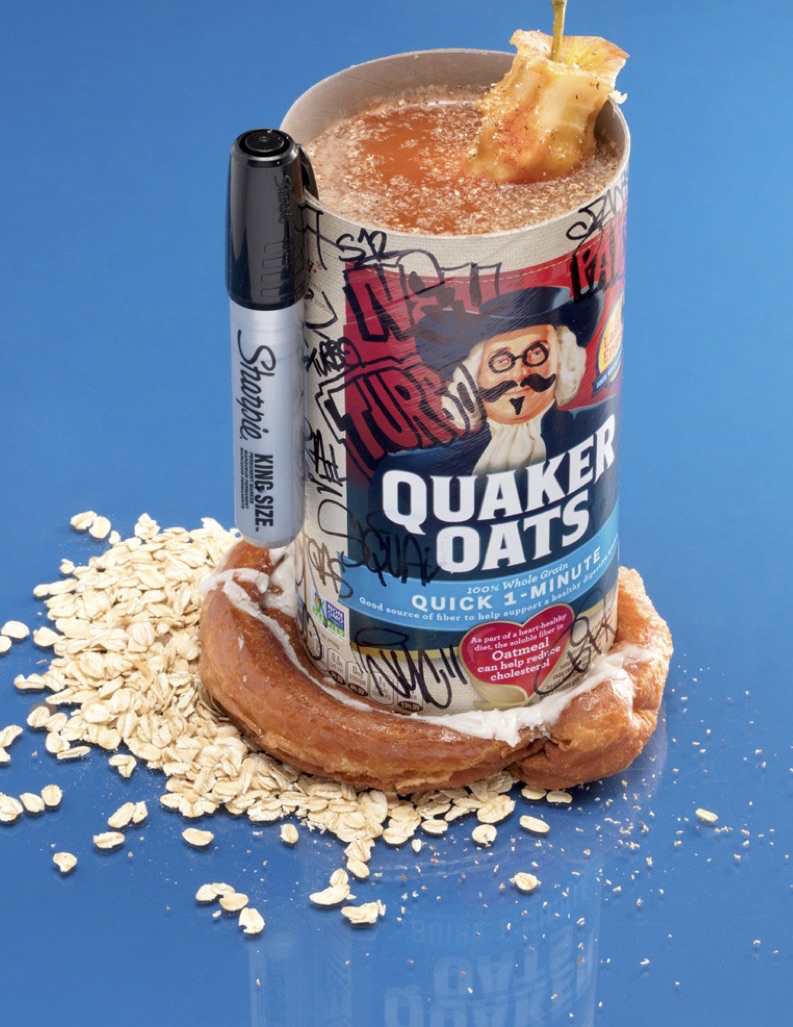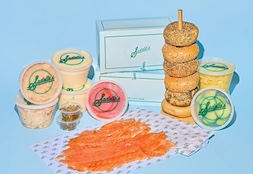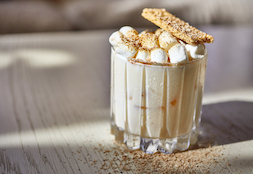Aaron Goldfarb is a whiskey lover, certainly, but he’s not a whiskey lover the way your dad or snooty friend are whiskey lovers, hording their favorite bottles, drinking everything neat, turning their nose up at the mere suggestion of a cocktail. To him, whiskey is not sacrosanct; it’s just booze.
“I wrote the book because whiskey was getting so geeky and un-fun, where people were just buying bottles as investments and storing it,” he says. “It was kind of trying to tell people, this is a product that gets people drunk, not [one] to sit in the corner of your apartment. Start playing around with it and stop treating it like a sacred object.”
The “book” is Hacking Whiskey, and it’s a collection of insider tips, musings, recipes, big ideas and irreverent asides from the forefront of the whiskey world—which, today, exists as much on the internet as it does in any bar or distillery. It’s there that Goldfarb, a frequent contributor to Esquire and Punch, discovered his fellow whiskey tinkerers, who were willing to divulge their methods for inventive fat washes, blends, finishes, infusions and more. These include experiments with pork belly ramen, actual leather, foie gras and weed (spoiler: it does get you high).
With the holiday season fast approaching, we called up Goldfarb to discuss the whiskey avant-garde and demystify some of his greatest “hacks.” We also secured a tasty little oatmeal bourbon recipe for you to try...
You can thank us later.
So how did you get into this kind of stuff in the first place? What prompted you to write the book?
I’m a whiskey drinker and a whiskey geek and a writer, and like a lot of freelance writers, I waste a lot of time goofing around on the internet instead of working. And the internet is kind of where the avant-garde is happening with whiskey at the moment. It’s where a lot of geeks are buying and trading it quasi-illegally. And it’s where a lot of these dudes have so much whiskey they don’t know what to do with it, so they’re blending it, they’re finishing it, they’re doing a lot of the things in the book. From the get go the idea of paying around with your whiskey—which has so long been really kind of staid and formal and ‘don’t do anything more than add a drop of water’—was really intriguing to me.
As a writer in the food and drink space myself, I’ve noticed a lot more of these crazy whiskey cocktails popping up. Have you noticed a big uptick? And what would you attribute that to?
Yeah, and I think there are a few reasons. Like everything, the world’s driven by coming up with cool stuff you can post on Instagram. So these bars can’t just have five cocktails that look boring in the glass. They’re constantly trying to come up with cool things. Likewise, guys like us need things to write about, and the bars know that. They know that if they make a foie gras fat-washed cocktail there’s a pretty good chance we might cover it. It’s a little cynical, both what bartenders and bars are trying to do, but if it’s fun and tastes delicious I don’t care if they’re trying to get guys like us duped into writing about it.
What makes whiskey better than other kinds of spirits for these kinds of hacks?
I’m not sure it actually is. In a way, tiki bartenders have been hacking rum from the get go. But whiskey is good because it has a nice base of flavors that mixes well with lots of other flavors, whether that’s caramel, vanilla, smoke, leathery flavors...It’s also high proof, which lends itself to extracting flavors from foods and barrels and stuff.
It’s also still relatively cheap. I mean, you can still get a Wild Turkey 101 for 20 bucks. And believe it or not, it’s hard to screw up these kind of experiments, because whiskey already tastes so good. Even blending it with something stupid, it typically still works out.
What are some mistakes that the casual whiskey drinker makes when he’s buying whiskey?
To get seduced by the so-called unicorn bottles, like Pappy or what not. It’s getting seduced by false marketing stories that brands have worked up, you know, the idea of limited-edition products...And it’s also not believing that bottom shelf products, which have been around for hundreds of years, are actually good, but of course they are. A lot of the old Kentucky and Scottish brands, $20 or $30 bottles, that we kind of ignore—they’re great.
Can you give us a brief overview of the difference between finishing, fat-washing and infusing?
Finishing is more of an industry term, and that’s what’ simply referred to as taking a pretty much already completed whiskey—a well-aged whiskey—and putting it in a different kind of barrel. For the longest time, scotch has been finished if not completely aged in sherry barrels, but it’s only recently where the distilleries realized that using the term finishing could be seen as a marketing aspect and could add additional flavor to a whiskey without adding a gimmicky flavor.
Infusions and fat washes are essentially the same thing, it’s just a matter of what you’re using. If something doesn’t have fat, it’s just Skittles or something, if you just put it into alcohol the flavor will naturally infuse, you filter it out and you’re good to go.
The trick came when people needed to figure out how to infuse something like meat into a whiskey. You obviously can’t just put a hunk of ground beef into a bottle and hope for the best. So what you had to do—and this was only figured out about 10 years ago—is render the fat from the meat or the butter or the chocolate, infuse it into the alcohol and then freeze the alcohol. Because of course alcohol doesn’t freeze but fat does, so the fat will rise to the top. And then you cut that off, filter it and you have the flavor but you don’t have the fat greasy residue in it.
What are some obstacles for the person who wants to make this at home but is, like, ‘Oh, this is going to be super tough or expensive’?
Well yeah, a lot of people don’t own hundreds of bottles of whiskey like I do, so I understand they don’t want their one or two purchases to possibly be ruined by bacon or something. That’s why you want to start with a cheaper product. And yeah, you’re going to drop a little money to experiment,t but you drop a little money cooking, too.
The thing I’ll say is it does work out, if you’re patient and you trust that it’s going to work out. I’ve literally never had a fat washing go wrong. But if you’re scared about starting with a crazy fat wash or something, it might be better to start with a simple infusion, like the candy infusions, and ones like that you can of course start with smaller amounts. The fat wash, you’d want to probably use a whole bottle.
What are some unexpected infusions or fat washes that you’ve found work very well?
Straight butter works a lot better than you think. One of my favorite cocktails in the book is from this bartender in Brooklyn, her name is Meaghan Montagano, she uses buttered blue corn—I think she uses two full blocks of butter—and it really makes a luscious, delicious whiskey. A lot of the higher end ones that sound like sheer gimmicks, like foie gras or truffles, actually work very well. There’s a leather-infused whiskey in the book, which is totally absurd. It’s from a German beer garden in Houston and they wanted to make whiskey that tastes like lederhosen.
That sounds gross, but is it good?
Yeah, it actually tastes good. Leather is a note in certain bourbons and scotches. You have to of course use smooth grade leather, not just your baseball glove or something. Yeah, it works out and it’s cool, a little S&M-y, but not bad.
With these kinds of infusions, can you really taste the particular flavors? Or is it more about bringing out particular aspects of the whiskey?
The meat ones are always going to add an intense meatiness, but as I was saying earlier, whiskey is really hard to ever fully outshine, so it’s kind of a little bit of both. Accenting while amplifying. You’re going to taste things. You’d be pretty pissed off if you bought luxury truffles or whatever and the whiskey didn’t taste much better.
You mention several methods for infusing whiskey with weed. Does it work well? Does it get you high?
There’s some debate on that and I’m actually not allowed to smoke weed by doctor’s orders [laughs]. It does work. The volcano [Ed. Note: a very fancy kind of vape] investment is pretty cool. That, in my opinion, adds a lot more aromatics. The MagicalButter machine creates an herb butter and you essentially fat wash with that. And that does bring all the THC and stuff over. That does work. And does get you high.
Per Goldfarb’s recommendation, we’ve included a recipe from the book, for the Turbo Quaker (created by Dallas barkeep, Scott Jenkins). It’s made with oatmeal bourbon, relatively easy to make and very appropriate for late fall...

Turbo Quaker
2.5 oz Turbo Quaker batch*
1 egg white
0.5 oz almond orgeat
Fee Brothers black walnut bitters
Grated nutmeg
Pour the Turbo Quaker Batch and egg white into a shaker with ice; shake with or 7 “hard” shakes; strain into an empty shaker using a Hawthorne strainer; dump the ice from the half of the shaker; add the almond orgeat and a Booker & Dax Cocktail Cube, then close the container and shake aggressively until frothy. Pour the cocktail through a chinois into a chilled coupe glass. Garnish with a swipe of bitters and grated nutmeg.
*Turbo Quake batch
1 liter bourbon, preferably higher proof with a high-rye profile
6 oz steel-cut oats
3 cinnamon sticks, cracked
Pour the bourbon into a vessel containing the steel-cut oats and drop the cracked cinnamon sticks into the liquid. After letting the infused bourbon mixture stand for 3 hours, pour the solution through a strainer into a saucepan to remove the largest particles. Heat the solution on low, stirring frequently for 10 minutes, without allowing the solution to boil. After it cools, pour through a coffee filter or other very fine-mesh strainer to remove any remaining particles.






